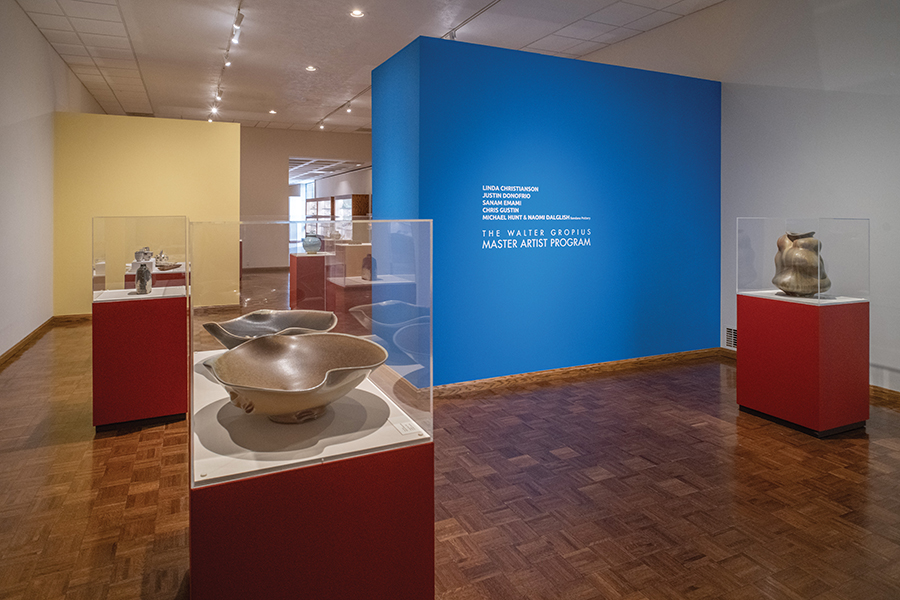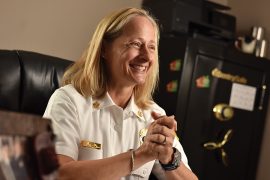Fifty years ago he designed a striking addition to the Huntington Museum of Art. Today four new exhibits pay tribute to the world-renowned architect and artist.
By James E. Casto
HQ 111 | AUTUMN 2020
On March 17, 2020, the COVID-19 pandemic forced the Huntington Museum of Art to close its doors to the public. After being closed for more than three months, it reopened on July 7 with safety protocols in place, including the wearing of masks, following social distancing guidelines and limiting the number of visitors. But even with those precautions in place, the museum anticipates being a busy place this fall as it puts on display four exhibitions inspired by famed architect Walter Gropius.

One exhibit details the role Gropius played in designing the museum’s 1970 addition. A second celebrates his impact on the art world and the influential Bauhaus school of design he founded. And two other exhibits feature the work of artists who have participated in the museum’s Gropius Master Artist Program as well as six contemporary ceramic artists who have been influenced by Gropius and the Bauhaus school of design.
“It’s wonderful to have an exhibition that focuses on the Huntington Museum of Art’s claim to fame —having renowned architect Walter Gropius design the expansion to our building in 1970,” said HMA Executive Director Geoffrey K. Fleming. “We planned for this exhibit to coincide with the 50th anniversary of the completion of this expansion and its opening to the public.”
Born in Berlin in 1883, the son of an architect, Gropius established a reputation as a remarkably talented designer early in his career. From 1914 to 1931, he headed the Bauhaus, an influential school of architectural design. When Hitler came to power, Gropius fled his native Germany, practicing first in London and then coming to the U.S. where he headed the Harvard University Graduate School of Design. Retiring from Harvard in 1952, he joined with a group of associates to form The Architects Collaborative.
How did it happen that a famous architect came to Huntington to work on an expansion of the museum?

“The story began in 1966 with the award of a $1 million grant from the Henry L. and Grace Rardin Doherty Foundation that was earmarked for expanding the museum,” said Senior Curator Chris Hatten. “At that time the head of the foundation was Walter L. Brown, whose father, Douglas W. Brown, had been a partner with museum founder Herbert Fitzpatrick in the Huntington law firm of Fitzpatrick, Brown and Davis.”
The museum long had needed more room, and that need became urgent when Ruth Dayton of Lewisburg, West Virginia, presented the museum with a collection of more than 300 priceless artworks she and her husband, Arthur, had collected over the years.
A committee appointed by the museum’s Board of Trustees to find an architect for the badly needed expansion project was frustrated by their inability to attract a prestigious firm to undertake the work.
 “Everybody, including noted architect Phillip Johnson, was turning them down,” said Hatten. “Then Eloise Campbell Long, a member of the museum’s board, got personally involved. She and her husband were regular vacationers at Castle Hot Springs, a resort in Arizona, a place that was also frequented by Walter Gropius and his wife Ise. Mrs. Long had become friends with the couple during their many visits to the resort; and when the museum’s expansion project was announced, she audaciously asked Gropius if he would undertake the design of the new wing in Huntington. Much to her pleasant surprise, he agreed to take on the project in partnership with his firm, The Architects Collaborative.”
“Everybody, including noted architect Phillip Johnson, was turning them down,” said Hatten. “Then Eloise Campbell Long, a member of the museum’s board, got personally involved. She and her husband were regular vacationers at Castle Hot Springs, a resort in Arizona, a place that was also frequented by Walter Gropius and his wife Ise. Mrs. Long had become friends with the couple during their many visits to the resort; and when the museum’s expansion project was announced, she audaciously asked Gropius if he would undertake the design of the new wing in Huntington. Much to her pleasant surprise, he agreed to take on the project in partnership with his firm, The Architects Collaborative.”
Gropius insisted that all of the firm’s projects be collaborative team efforts, although each commission had two architects who were considered “more equal than the others.” At Huntington, Gropius, then in his 80s, was elected to be principal in charge, and Malcomb Ticknor was appointed associate in charge. When Gropius died before the project was finished, Ticknor completed it.
Yet another current exhibit at the museum celebrates the work of sculptor Harry Bertoia, who designed the much-loved Marshall Memorial Fountain. A prolific and versatile artist, Bertoia was internationally famous before his creation of the Marshall Memorial. He was, by turns, a metal crafter, jewelry maker, graphic artist, furniture designer and sculptor, who pioneered what is sometimes called “sight and sound” sculpture.
To limit the number of visitors, the museum is using Eventbrite, an online ticketing system. Visitors can acquire tickets using their smartphone, tablet or home computer. To book Eventbrite tickets, log on to www.hmoa.org/covid-19. Anyone needing assistance with this process can call the museum at (304) 529-2701.





